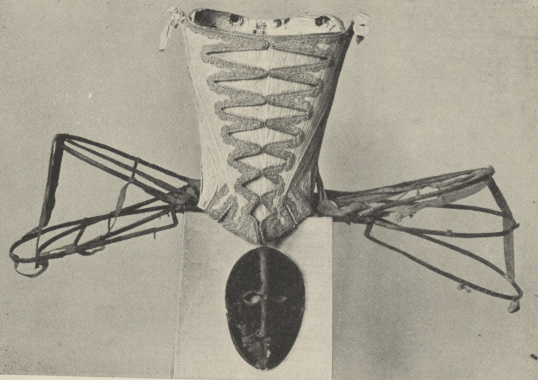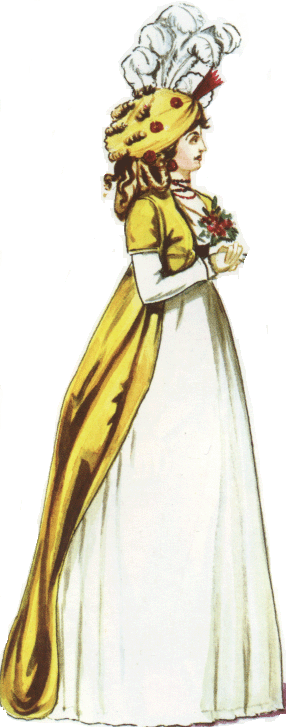
The Dress in Review
How the Eighteenth Century treated the lady's gown-classic innovations through the past one hundred years.

The Dress in Review
How the Eighteenth Century treated the lady's gown-classic innovations through the past one hundred years.
We stand at the doorway to a new century, watching the final days of 1799 glide rapidly by to join the ranks of the minutes, hours, days and years that comprise the exalted history of our English Empire. As we look eagerly forward, exhilarated with the promise of the time to come, we cannot help but pause and turn at the threshold to glance fondly back into our collective past and appreciate the circumstances that have brought us to this monumental moment. Gazing back at our ancestors, we are filled with a sense of fondness and pride as we think to ourselves "Oh my God, what were they wearing?"
Yes, readers, as the crown fought to create an empire upon which the sun never sets, the world of fashion waged battles to decide the fate of hoops and hem lines, panniers and petticoats. And although taste was often among the casualties, the Eighteenth Century was not without its ingenious outfit innovations. Nowhere was the battle more fierce, or the cause more worthy, than in the area of lady's dresses.
The Hoop
Of course, any worthwhile discussion of gowns in the 1700's must begin with the invention of the hooped petticoat in the first decade of the century. At this time, designers contrived to create a petticoat made of stiff, heavy canvas and strengthened with whalebone to form an enormous under structure beneath which went the slim skirt and over which went the gown. This provided an alternative to the several layers of stiff petticoats that could also be used to achieve the same effect.

But perhaps the most important thing about the hoop is that it provided the fashion world with something to argue about for over fifty years. By 1714, designers had already raised the question of round versus flat. Should skirts be conical, becoming an ever-widening circle as they descended from waist to floor? Or should the front and back remain flat while the sides thrust outward from the body, causing the perimeter of the hem to assume a rectangular shape? (The later being what our male fashion editor likes to refer to as the "hippo hips" effect.)
And then there was the ever-present issue of size. (Oh, get your mind out of the gutter. I'm still talking about dresses here.) Exactly how much space should a lady occupy when she entered a room? Just how big was big, and was bigger truly better? Some sources suggest that the circumference of a skirt was sometimes as great as twenty-four yards (Brooke, p. 93-94). Others indicate that by 1740, hoops could be as wide as three feet, four inches from hip to hip (Barton, 312) . To our modern imaginations, both figures seem a bit outlandish and tend to justify critics of the time who claimed that the hoop was "unwieldy and destructive" (Brooke, p. 93-94).
The size of the hoop even made it necessary to change the fashions pertaining to head apparel. With the hooped petticoat, smaller bonnets replaced tall headdresses in order to prevent the woman's body from assuming abnormally large proportions. (Later designers took a different approach, replacing the hoop with wide panniers that allowed for visual balance of the hips with large head pieces (Gorsline,p. 98)).

In spite of the controversy surrounding the hoop, history reveals that it has been more than a passing fad. In fact, it is a fashion that has managed to hold its own for a significant part of the Eighteenth Century. Therefore, we must say hats off to the hoop!
The Sacque
While we all agree that the French can be a somewhat bothersome people, we must give them credit for their contributions to the world of fashion. Most of all, we must salute them on the triumphant introduction of the sacque or "sack back", the gown that they like to refer to as "the Watteau." This gown premiered in England in about 1750 and has only just begun to fade from the fashion scene in the past ten or twenty years.
The back of this gown, consisting of the four box pleats (two at each shoulder) sewed flat against the back of the dress for a few inches and then flowing loosely down the back to end in a train has presented many opportunities for innovation. For instance, there was the "monkey tailed" fashion, in which the train was "caught together in a twist about a foot from the ground, then allowed to hang free" (Chalmers, p. 215). There was also the "trollopee," which was "a loose morning gown with an open front and gathered back, worn in about 1750" (Chalmers, p. 215).
Finally, there was the "polonaise" or "slammerkin," which had "an open front looped back on panniers and ending in a train" (Chalmers, 215). With its fitted bodice and its lull skirt that looped to form three drapes over a second, separate skirt, there was no fashion more popular in the 70's (Barton, 344).
Perhaps the best aspect of all of these designs, however, was that they allowed us to show off our most elaborate and decorative petticoats. The requirement that the petticoats be of a different material and color, and not match the gown was essential, as well, as it provided the opportunity to exhibit a bit of daring and personal flair (Chlamers, 215). And of course, the classic black velvet ribbon, or ruching, worn about the neck was always an excellent finishing touch.
Once again, we have a keeper!
The Square Cut Bodice
Throughout the Eighteenth Century, the square cut bodice has remained a fashion classic. In the first part of the century, it was usually finished with a flower wreath, ruffle or lace. Soft neck ruffs were also common, a holdover from the days of Elizabeth's reign, although these were generally smaller than those used in the sixteenth and seventeenth centuries.
In the days of the sacque, we often saw the gauze modesty covering the low neck. Later on came the development of the "fichu."
And of course, there have been other changes to the overall shape of the bodice. We started the century with the long, pointed bodice that followed the shape of the corset. Now, as the century draws to a close, we see the waistline rising increasingly towards the bust line and emphasizing the bosom. The backs have gone from fitted to flowing. Still, the square cut of the neckline remains with us, making this perhaps one of the most enduring styles we have seen this century.
Bustles, Sleeves and Hemlines in Transition
During the reign of George II, we saw the gradual transition from hoops into panniers, and from panniers to bustles. This transition accompanied the continual slimming of the skirt during this period. By about 1780, the draping, taping, stringing and scalloping of the skirts that we saw during the 70's was out of fashion and only a bustle (often complimented with a sash tied in a bow) or straight form was shown (Barton, p. 344).

At the same time, round waists and sashes became the norm for all but the most formal dresses. And at last, we round out the century (if you'll pardon the pun) with the "cork rump," which provides us with an additional rump that makes our waists appear smaller and more proportionate (Brummel, p. 296). And this, as we know, is precisely what every girl wants.
We saw the century begin with the timeless elbow sleeves, which are yet another fashion that have followed us through the greater part of the 1700's. We watched cuffs appear on the scene, widen, narrow and then disappear altogether to be replaced with lace. Sleeves shorted, swelled, puffed up, deflated and finally lengthened to the wrist, where, (these days, at least), they often terminate in white ruffles.
And then there are hem lines, which have, for the most part, been on their best behavior for the past one hundred years. Of course, there was that rather brief period around the middle of the century (when many of our most shameful fashions, including the glass bottled bouquets that were sometimes tied to the waist circa 1770). During this time, hem lines were raised to shameful levels, often only reaching the instep or ankle or, at times, even higher. Fortunately, this brief lapse was cleared up by about 1780, when hems resumed their rightful position and began once again to kiss the floor . . .
. . . So in conclusion, as we prepare to step forward into the approaching century, we glance back for that brief, nostalgic instant and, with a final wave to dear departed, we can finally say to ourselves with great assurance "We've come a long way, baby!" And smiling with the glowing confidence of the well dressed, we bid adieu to the century that is past and gratefully embrace the year 1800.
- Jessica Hallmark, Artistic Director
Enlightened Elegance